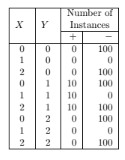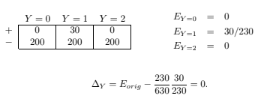Build a decision tree on the data set. Does the tree capture the “+” and “?” concepts?
Following is a data set that contains two attributes, X and Y , and two class
labels, “+” and “?”. Each attribute can take three different values: 0, 1, or 2.

The concept for the “+” class is Y = 1 and the concept for the “?” class is
X = 0 ? X = 2.
There are 30 positive and 600 negative examples in the data. Therefore,
at the root node, the error rate is
Eorig = 1 ? max(30/630, 600/630) = 30/630.
If we split on X, the gain in error rate is:

If we split on Y , the gain in error rate is:

Therefore, X is chosen to be the first splitting attribute. Since the
X = 1 child node is pure, it does not require further splitting. We may
use attribute Y to split the impure nodes, X = 0 and X = 2, as follows:
• The Y = 0 and Y = 2 nodes contain 100 ? instances.
• The Y = 1 node contains 100 ? and 10 + instances.
In all three cases for Y , the child nodes are labeled as ?. The resulting
concept is
You might also like to view...
The ___________________ attribute is used to uniquely identify an HTML element.
Fill in the blank(s) with the appropriate word(s).
Describe what happens when you insert an element in a vector whose memory is exhausted.
What will be an ideal response?
Prove that the basic two-phase locking protocol guarantees conflict serializability of schedules. (Hint: Show that, if a serializability graph for a schedule has a cycle, then at least one of the transactions participating in the schedule does not obey the two-phase locking protocol.)
What will be an ideal response?
A _____ is an internal or external entity that could endanger an asset.
A. proxy B. facade C. firewall D. threat